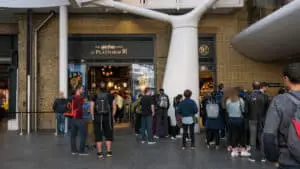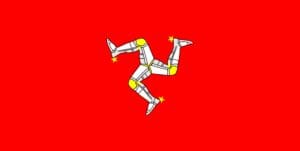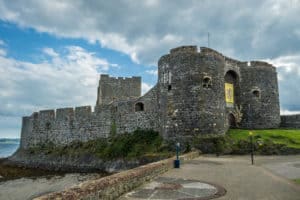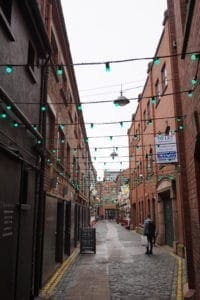The Son of Protagoras Mural, Belfast
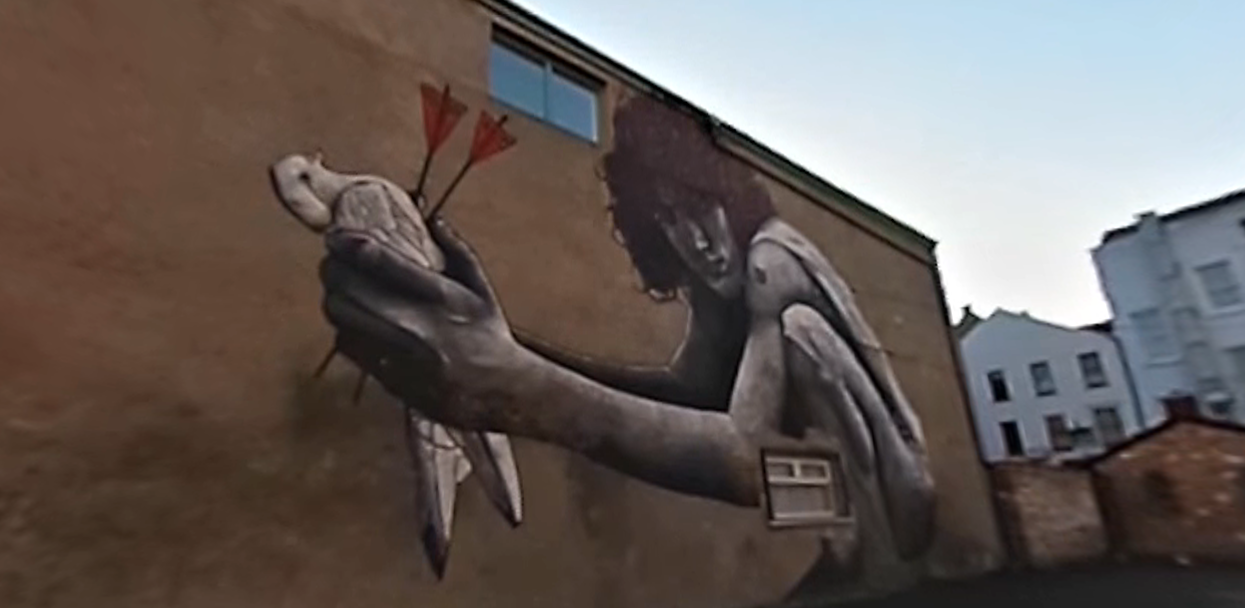
Updated On: March 21, 2024 by Ciaran Connolly
The heart of Belfast, amidst the labyrinthine streets that bear the weight of history and hope, stands a testament to artistic ingenuity and socio-political commentary. The Son of Protagoras mural, a striking creation by the elusive street artist Banksy, emerges as a beacon of Belfast’s vibrant cultural identity. With its enigmatic title and evocative imagery, this mural transcends mere urban decoration, weaving a narrative that invites contemplation and discourse.
As we delve into the depths of this captivating artwork, we uncover layers of meaning, shedding light on the complexities of human existence, the echoes of history, and the resilience of the human spirit. Join us on a journey through the streets of Belfast as we unravel the mysteries and marvels of The Son of Protagoras mural. This iconic masterpiece continues to captivate hearts and minds alike.
The Origins of The Son of Protagoras Mural
Banksy, a pseudonymous England-based street artist, is renowned for his politically charged and thought-provoking artworks that often carry powerful social messages. The Son of Protagoras mural is no exception. It first appeared on the streets of Belfast in [insert year], sparking conversations and debates about its significance.
The title is a nod to Protagoras, a pre-Socratic Greek philosopher known for his relativist views, particularly in his famous statement, “Man is the measure of all things.” This philosophical reference adds complexity to the mural, inviting viewers to contemplate the nature of truth, perception, and human existence.
The Visual Narrative
At first glance, The Son of Protagoras mural strikes viewers with its bold imagery and striking composition. The central figure, a young boy wearing a hoodie and holding a brush and a bucket of paint, stands atop a ladder, seemingly in the act of painting over a phrase scrawled on the wall: “There is always hope.”
This juxtaposition of hope and its potential erasure is a recurring theme in Banksy’s work, challenging viewers to confront the fragility of optimism in a world fraught with adversity. The boy’s determined expression and purposeful stance convey a sense of defiance against despair, embodying the resilience of the human spirit in the face of adversity.
Surrounding the central figure are various symbols and motifs that add depth to the mural’s narrative. A dove, a universal symbol of peace, flies above the boy, its wings outstretched in flight. Yet, even this symbol of hope is not immune to the ravages of conflict, as its body appears riddled with bullet holes—a poignant reminder of the violence that has scarred Belfast’s history.
Social and Political Commentary
Like many of Banksy’s works, The Son of Protagoras mural serves as a platform for social and political commentary. In the context of Belfast, a city marked by decades of sectarian conflict known as the Troubles, the mural takes on added significance.
“There is always hope” can be interpreted as a message of resilience and optimism in adversity. This sentiment resonates deeply with Belfast’s journey towards peace and reconciliation. However, painting over this hopeful message raises questions about the fragility of peace and the ever-present threat of violence and division.
Moreover, the presence of the young boy as the central protagonist underscores the importance of future generations in shaping the trajectory of society. By depicting a child engaged in an act of creation, Banksy celebrates the transformative power of art and creativity in fostering positive change.
Impact on the Community
Since its creation, The Son of Protagoras mural has become integral to Belfast’s urban landscape, attracting visitors from far and wide who come to admire its beauty and contemplate its deeper meanings. The mural has also sparked dialogue within the local community, prompting discussions about art, politics, and the city’s identity.
In addition to its cultural significance, The Son of Protagoras mural has had a tangible impact on the surrounding area. Street art can revitalise neglected spaces, transforming derelict walls into vibrant canvases that breathe new life into urban environments. By choosing to paint in Belfast, Banksy has contributed to the city’s cultural renaissance, helping to redefine its image on the global stage.
Controversy and Conservation
Despite its popularity, The Son of Protagoras mural has not been without controversy. By its very nature, street art is temporary, subject to the whims of time and the elements. Over the years, the mural has faced threats from vandals, graffiti artists, and even local authorities seeking to remove or whitewash it.
In response to these threats, local activists and art enthusiasts have rallied to protect and preserve The Son of Protagoras mural, recognising its cultural and historical significance. Efforts to safeguard the mural have included initiatives to monitor and maintain its condition and campaigns to raise awareness about the importance of street art as a form of cultural heritage.
Attractions Near The Son of Protagoras Mural
The Son of Protagoras mural is a captivating testament to artistic expression and social commentary. Yet, this masterpiece is just one gem in a treasure trove of cultural attractions that dot the city’s streets. As visitors stroll through the labyrinthine alleys surrounding the mural, they will discover many landmarks and points of interest that offer insight into Belfast’s rich history and dynamic character. From historical sites to culinary delights, here are some of the top attractions near The Son of Protagoras Mural:
1. Belfast City Hall: Just a short walk from The Son of Protagoras mural lies Belfast City Hall, an architectural marvel that serves as the city’s civic heart. Visitors can explore the grandeur of this iconic building, admiring its elegant façade, ornate interiors, and sprawling gardens. Guided tours offer insight into Belfast’s political history and cultural heritage, making it a must-visit destination for history enthusiasts.
2. St. Anne’s Cathedral: A testament to Belfast’s religious heritage, St. Anne’s Cathedral is a stunning example of neo-Romanesque architecture. Visitors can marvel at its intricate stained glass windows, towering spires, and serene interior. Guided tours provide an opportunity to learn about the cathedral’s history and significance within the community.
3. Titanic Belfast: Situated on the banks of the River Lagan, Titanic Belfast offers an immersive journey into the history of the world’s most famous ocean liner. From interactive exhibits to full-scale reconstructions, visitors can explore the Titanic’s tragic tale and its enduring legacy. The adjacent Titanic Quarter also features museums, galleries, and eateries, making it a hub of cultural activity.
4. Cathedral Quarter: Adjacent to The Son of Protagoras mural lies the Cathedral Quarter, a vibrant neighbourhood renowned for its artistic flair and lively atmosphere. Cobblestone streets are lined with galleries, theatres, and artisanal shops, offering a glimpse into Belfast’s burgeoning arts scene. Visitors can also indulge in the area’s eclectic culinary offerings, from traditional Irish pubs to trendy cafes and restaurants.
5. Peace Walls: As a city scarred by decades of sectarian conflict, Belfast bears witness to the enduring legacy of division through its Peace Walls. These imposing barriers, erected during the Troubles, serve as a stark reminder of the city’s turbulent past. Guided tours provide insight into Belfast’s journey towards peace and reconciliation, offering a poignant reflection on the resilience of its people.
6. Botanic Gardens: A tranquil oasis amidst the bustling cityscape, Botanic Gardens offers respite and recreation for visitors of all ages. From lush greenery to exotic flora, the gardens boast diverse plant life, making it a haven for nature lovers and botany enthusiasts. The iconic Palm House and Tropical Ravine glimpse Belfast’s Victorian heritage, while the surrounding parkland offers ample space for picnics and strolls.
As visitors explore the attractions near The Son of Protagoras Mural, they will uncover the diverse tapestry of Belfast’s cultural heritage. Each landmark offers a window into Belfast’s storied history and vibrant spirit, from architectural marvels to poignant reminders of the city’s past. Whether wandering through the bustling streets of the Cathedral Quarter or immersing oneself in the solemn beauty of St. Anne’s Cathedral, a journey through Belfast will leave a lasting impression on the hearts and minds of all who venture here.
When to Experience Belfast’s Charms
The best time to visit Belfast largely depends on individual preferences and interests. However, many travellers find that May to September offers the most favourable weather conditions for exploring the city’s outdoor attractions and cultural events. During this period, temperatures are generally mild, and daylight hours are longer, providing ample opportunity to wander through Belfast’s picturesque streets and lush green spaces.
Additionally, summer brings a vibrant calendar of festivals and events, including the Belfast Maritime Festival and Belfast Pride, which showcase the city’s rich cultural heritage and dynamic arts scene. For those seeking to avoid crowds and take advantage of lower accommodation rates, the shoulder seasons of spring and autumn can also be ideal times to visit, offering pleasant weather and fewer tourists. Whether one visits Belfast during the bustling summer or the quieter seasons, the city’s charm and hospitality will leave a lasting impression year-round.
Conclusion
In the heart of Belfast, amidst the bustling streets and crowds, The Son of Protagoras mural stands as a testament to the power of art to inspire, provoke, and unite. The mural invites viewers to engage with complex themes of hope, resilience, and the human condition through its striking imagery and thought-provoking symbolism.
As Belfast continues to evolve and redefine itself in the 21st century, The Son of Protagoras mural serves as a beacon of the city’s artistic identity, reminding residents and visitors alike of the enduring power of creativity to shape our world. Whether viewed as a political statement, a philosophical allegory, or simply a stunning work of art, Banksy’s mural has left an indelible mark on the cultural landscape of Belfast, ensuring its place in the annals of urban art history for generations to come.


